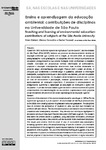Mostrar o rexistro simple do ítem
Ensino e aprendizagem da educação ambiental: contribuições de disciplinas na Universidade de São Paulo
| dc.contributor.author | Battaini, Vivian | |
| dc.contributor.author | Sorrentino, Marcos | |
| dc.contributor.author | Trovarelli, Rachel | |
| dc.date.accessioned | 2019-03-28T09:54:36Z | |
| dc.date.available | 2019-03-28T09:54:36Z | |
| dc.date.issued | 2017 | |
| dc.identifier.citation | Ambientalmente Sustentable, 2017, 23-24: 199-216. ISSN: 1887-2417 | es_ES |
| dc.identifier.issn | 1887-2417 | |
| dc.identifier.uri | http://hdl.handle.net/2183/22405 | |
| dc.description.abstract | [Resumo] A partir de 1983, na Escola Superior de Agricultura “Luiz de Queiroz”, da Universidade de São Paulo (ESALQ/USP), inicia-se um processo de desenvolvimento da área de educação ambiental, que culmina com a criação, já nos anos 2000, de disciplinas para graduações e pós-graduações. As disciplinas têm em comum a perspectiva de estudantes protagonizarem a sua própria formação como profissionais e cidadãos/cidadãs. Ancoradas em perspectivas teóricas relacionadas ao ambientalismo, utopismo e educação emancipatória, desenvolvem duas técnicas destacadas no presente artigo: Mínima/Máxima Intervenção Possível (MIP) e Diário de Bordo. A pesquisa que fundamenta o presente artigo é qualitativa, utilizando a observação participante, avaliações processuais e intervenções educadoras junto aos estudantes das mencionadas disciplinas. Os resultados demonstraram-se positivos sob o ponto de vista do envolvimento e participação, restando questionamentos sobre o real aprofundamento de conteúdos específicos. É perceptível o desenvolvimento do protagonismo, autonomia e capacidade de articulação de conteúdos e ações nos estudantes. O uso das técnicas citadas sugere favorecer o desenvolvimento de sujeitos comprometidos com transformações de seu território e apresenta-se como proposta de aprimoramento de processos de ensino aprendizagem na educação superior. | es_ES |
| dc.description.abstract | [Abstract] A process of development of the environmental education area began in 1983 at Escola Superior de Agricultura “Luiz de Queiroz”, of Universidade de São Paulo (ESALQ/USP). In the 2000s were creating subjects for graduation and post-graduation. The disciplines have in common the perspective of students to carry out their own formation as professionals and citizens. The theoretical perspectives are based to environmentalism, utopianism and emancipatory education. They develop two techniques highlighted in this article: Minimum / Maximum Possible Intervention (MIP) and Logbook. The research that bases the present article is qualitative, using participant observation, procedural evaluations and educative interventions with the students of the mentioned disciplines. The results were positive from the point of view of involvement and participation, remaining questions about the actual deepening of specific contents. It is noticeable the development of the protagonism, autonomy and capacity of articulation of contents and actions in the students. The use of the mentioned techniques suggests in favor the development of subjects committed with transformations of their territory and presents itself as proposal of improvement of teaching learning processes in higher education. | es_ES |
| dc.language.iso | por | es_ES |
| dc.publisher | Universidade da Coruña, Servizo de Publicacións | es_ES |
| dc.rights | Atribución-CompartirIgual 3.0 España | es_ES |
| dc.rights.uri | http://creativecommons.org/licenses/by-sa/3.0/es/ | * |
| dc.subject | Educação ambiental | es_ES |
| dc.subject | Universidade | es_ES |
| dc.subject | Ensino-aprendizagem | es_ES |
| dc.subject | Environmental education | es_ES |
| dc.subject | University | es_ES |
| dc.subject | Teaching-learning. | es_ES |
| dc.title | Ensino e aprendizagem da educação ambiental: contribuições de disciplinas na Universidade de São Paulo | es_ES |
| dc.title.alternative | Teaching and learning of environmental education: contributions of subjects at the São Paulo University | es_ES |
| dc.type | info:eu-repo/semantics/article | es_ES |
| dc.rights.access | info:eu-repo/semantics/openAccess | es_ES |
| UDC.volume | 23-24 | es_ES |
| UDC.startPage | 199 | es_ES |
| UDC.endPage | 216 | es_ES |
| dc.identifier.doi | DOI: 10.17979/ams.2017.23-24.0.3376 |






